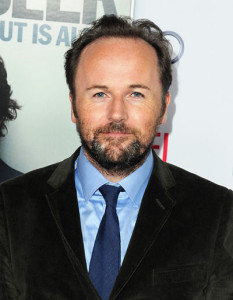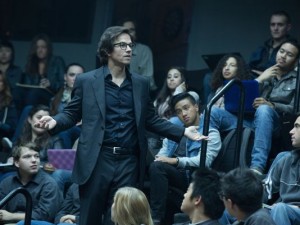 Disc Dish recently sat down with filmmaker Rupert Wyatt, whose best known for helming (Rise of the Planet of the Apes, the popular 2011 reboot of the beloved Apes franchise. His latest feature film isn’t a reboot but rather a remake in the form of a re-imagining of the 1974 drama The Gambler.
Disc Dish recently sat down with filmmaker Rupert Wyatt, whose best known for helming (Rise of the Planet of the Apes, the popular 2011 reboot of the beloved Apes franchise. His latest feature film isn’t a reboot but rather a remake in the form of a re-imagining of the 1974 drama The Gambler.
Taking its lead from the original film written by James Toback and directed by Karel Reisz, the remake is written by Academy Award-winner William Monahan (The Departed) and stars Mark Wahlberg (Ted) as Jim Bennett, a L.A. college literature professor with a severe gambling addiction caused by his view of the world as either having it all—or having nothing. Co-starring John Goodman (Argo), Brie Larson (21 Jump Street), Michael Kenneth Williams (TV’s Boardwalk Empire) and Jessica Lange (TV’s American Horror Story), it’s a startlingly effective and very cool flick—and one of the better remakes of a Seventies favorite that I’ve seen over the past few years.
The Gambler is currently available on Blu-ray, DVD, Instant Video, VOD and Digital HD from Paramount.
Disc Dish: I just finished watching all the bonus features on the Gambler Blu-ray and the disc producers did a bang-up job on it. These days, it’s usually only the big, effects-driven movies that receive that kind of treatment.
Rupert Wyatt: Yeah, it was wonderful. The team behind the discs was really looking to explore every aspect of the production. And the studio obviously supported it as well.
DD: Coming off Rise of the Planet of the Apes, I imagine you had a bunch of options for what to do next. Were you determined not to follow up Apes with an effects-filled project?
RW: ‘Determined’ might be too strong a word, perhaps, because I did have a real desire to do the sequel. I had a very specific idea for what it was going to be, but it wasn’t meant to be. Planet of the Apes was never my franchise—I came onto it after it was already in motion. But I was keen on my next film to be one where I was coming at it from the characters, and I had material I had a hand in developing. But when The Gambler came along, it seemed to me to be the perfect blueprint—a beautifully formed script with such rich characters.
DD: And how did it make it onto your desk?
RW: [Co-producer and star] Mark Wahlberg was the one who contacted me. There were previous iterations of this project—I think it was originally developed for Scorsese and DiCaprio, and then Todd Phillips was involved. I wasn’t part of that process. I got it clean from Mark and it was his project. As for me, first and foremost, I’m a cause-and-effect storyteller and that’s where I work best, perhaps—in genre filmmaking. So The Gambler proved to be a really good opportunity to try something different and do it in the context of a city that I’m fascinated by.
DD: You’ve lived in Los Angeles for a while?
 RW: Seven, eight years, yes, splitting my time between here and New York.
RW: Seven, eight years, yes, splitting my time between here and New York.
DD: The movie takes a rich, textured look at contemporary L.A. Which reminds me–I understand that one of your major influences is Hal Ashby?
RW: I should be so lucky to aspire to that! That for me, it many ways, was the reason I took on the film—to attempt a more freewheeling narrative that was primarily character-driven, like Ashby. He had an extraordinary gift to find that nearly impossible tone of pathos and drama and, at the same time, humor. It’s so evident in Shampoo and Being There.
DD: …and Harold and Maude.
RW: Absolutely. So for me, The Gambler was a stab at that. Whether I succeeded or failed is up to you to decide.
DD: We only have a few minutes, so I’ve gotta jump ahead to what I’m most curious about: How did George Kennedy happen? (Ed. Note: He appears in the film’s opening scene as Jim Bennett’s dying grandfather.)
RW: I’ve been a massive fan of his since I first saw Cool Hand Luke.
DD: What guy isn’t!?
RW: Here’s how it happened: He put himself on tape!
DD: Really?
RW: Yes. He was in semi-retirement in Boise, Idaho, and somehow he got hold of the script and he put himself on tape. My casting director came to me and said, ‘I’ve got a surprise for you,’ and he put it on. And I said, “That’s George Kennedy!” And he was outstanding. I wanted to go for an actor who was at an age where he could really relate to the character. And that’s hard—it’s difficult for older actors who are strong and competent and coherent.
DD: It must have been a great day on the set.
RW: It was. It was actually his birthday and we wrapped that day with a birthday cake. He turned 89 that day.
DD: Something that wasn’t covered in the bonus features that I really enjoyed was the film’s soundtrack, which included a handful of older songs along with a bunch of recent cover versions of older numbers.
RW: I actually was the music supervisor as far as those source pieces go. My sound editor Clint Bennett and Theo Green, one of our two composers, had suggestions that we used, as well. But it was really specific for me—I knew going into the movie that I wanted a soundtrack comprised of what Jim Bennett’s notions of what genius was. In the lecture scene, he says that it’s only possible to achieve greatness when you have it inside of you. Even though he learns by the end that there are grays areas to everything, particularly that notion of genius, I still wanted the soundtrack to be made of the genius artists of our time; from today and yesteryear, as well. That’s why Dinah Washington is in there. When I wrote, I put together a library of music that I listened to that eventually became the soundtrack to the movie.
DD: That lecture scene is a doozy. Bill Monahan’s script is filled with a handful of great monologues and dialogue sequences. Considering these days of short attention spans and over-the-top visual effects, what kind of discipline does a filmmaker have to bring to the show to give dramatic dialogue and speechifying its due?
RW: That’s a good question. And that certainly applies to the lecture scene at the beginning. For The Gambler, I wanted to create in the moments of performance within the movie an amphitheater-like environment. The lecture hall, the basketball game, the dragon room gambling den, we shot them like theater in the round, with a kind of elevated seating. The lecture scene, in particular, was approached like it was theater. Mark gave me that opportunity to do that—he had ten pages of dialogue in that lecture scene and he had it down cold, so I could really work on it over the course of the two days we shot. I wanted to make that lecture a performance, capture it as a performance. So it really was all about simply having the chance and the time to do it.
DD: And you did!
RW: I did. I think I did.
|
Buy or Rent The Gambler
|
|||
|---|---|---|---|
Instant Video |
 |
||

Leave a Reply